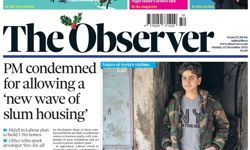The Financial Times is noted for its analytical journalism, thoughtful reporting and taking the longer-term view.
So you would expect the 126-year-old publication to take a similar approach on trying to work out its own future and the biggest decision that it, or indeed any publication has had to take in recent years, negotiating the digital transition path.
To a considerable extent, that is exactly what has happened - though not entirely.
John Ridding, the executive in charge, concedes, however, there has also been room for instinct, chance and experimentation in taking the total number of FT paying customers, in print, online and mobile to its current total of 677,000, the highest figure in the publication’s history and a 13 per cent year-on-year increase.
Core principles
According to Ridding, who was chief executive of the FT Group but who now also runs Pearson VUE, the company’s assessment and testing arm and its English language learning business in a new division called Pearson Professional, a number of underlying principles informed the FT’s approach to digital.
The FT management team were determined, whatever happened, to have a direct relationship with their readers and to hold on to the ability to set their own prices.
Around 2006, they did consider going for “a volume play” but even with the scale of the traffic being generated by search engines at the time, they judged it would be very hard for a news engine to generate enough volume.
There was also a strong belief that FT journalism was, and should continue to be, valuable in any format - an idea that ran counter to much prevailing wisdom as the internet expanded, that information should be free.
“We basically felt that we should be able to charge a reasonable price for FT journalism on whatever platform,” says Ridding who began his 26-year-career at the FT as a copy taster on the foreign desk.
He quickly moved on to be South Korea correspondent at a time of demonstrations and tear gas in the capital, Seoul.
“I still have the gas mask,” notes Ridding who went on to launch the FT’s Asian edition and later chair all Pearson’s activities in the region.
“I think that if I am completely honest, it (the digital policy) was two thirds deliberate and a third, a very important third, that was accidental and serendipitous when we developed the paid-for model online and the metered model which has now been copied quite broadly,” recounts Ridding.
The funnel approach
The idea was that you would have a funnel open at the top with a limited number of free articles to attract the traffic and then try to turn the visitors into subscribers.
Initially the funnel allowed access to 20 articles a month but the size of the bait has now been reduced to eight. Once you could get five articles before having to register. Now registration is mandatory if you want more than an opening paragraph.
Ridding admits that one of the things he had failed to understand in advance was the value of the data generated by such a business model.
In the not-too-distant past, a reader would be a largely anonymous figure who would go to a newsagent to buy a copy of the FT, and little was known about who they were or what they were reading.
“Now we know pretty much everything and that is incredibly powerful. It enables you to be more relevant and helps with everything from customer acquisition and retention to product development, targeting and advertising,” the executive explains.
As a result of the FT’s experience with funnels and subscription data, Ridding is highly resistant to plumping for either side in the conventional media punditry debate – the free advertising funded model versus paywalls and subscriptions.
“Our view is it’s both actually. We have gone for the middle ground because those two parts of the middle ground reinforce each other,” Ridding believes passionately.
First bring the audience in, turn them into subscribers, then you have proof of an engaged and dedicated readership, which can then be segmented to deliver to advertisers.
Ridding is equally dismissive of the idea that charging subscriptions is a relatively easy thing for the FT to get away with because it is a specialist publication and not so relevant for other publishers.
While being a “must have” purchase for many of its readers, more than 290,000 of whom are corporate users, Ridding argues that many more publications are in effect specialist because of the nature of their brand or of the content they offer.
Mobile, which now accounts for around 50 per cent of FT traffic and 20 per cent of subscriptions was another battleground where difficult choices had to be made.
In 2011, the FT withdrew its app for iPhones and iPads over a dispute with Apple over who owned the all-important data. Apple insisted sales had to take place via its Apple Store and also wanted 30 per cent of the revenue.
“We had to make a very difficult decision because our principles were direct relationship with our readers and pricing power. So we had to go off and build our own app in a fairly short period of time,” says Ridding.
The FT fit within Pearson
But why has the FT Group, which includes a 50 per cent stake in The Economist, been rolled up and included in what is referred to as the parent group’s professional line of business?
What has the journalism to do with language tuition and educational testing?
Ridding, now responsible for more than 7,000 employees in the combined division and revenues approaching £800 million a year, claims to see synergies, although the FT pillar of the professional line of business will continue to have its own very distinctive role.
“The main point should be to understand both inside and outside the FT, our primary purpose and focus should be the gold standard in world business journalism,” says Ridding who adds that, for instance, FT video and other FT content can be used in English language training for professionals.
The integration of the FT in a larger Pearson division might do something to dispel the periodic rumours that the FT might be for sale – rumours that have always been denied strongly by Pearson.
Print redesign
Another sign that Pearson remains committed to the FT in all its forms, including the pink paper newspaper, came with the September redesign of the paper, which appears to have been well received by both specialists and customers.
“The redesign shows that we continue to believe in print even though we have seen very rapid growth in digital and we think that print remains a powerful format,” says Ridding who believes that the company will continue to publish the newspaper for a long time to come. The current paper circulation is around 210,000.
The redesign, he argues, has produced a sharper and cleaner look to what is essentially a single edition paper across six columns rather than eight. In a reversal of traditional roles, in the digital first world, it is designed to complement the digital output rather than the other way around.
There is also a more simplified editorial process “under the bonnet” which has enabled resources to be redeployed to other areas including digital.
Costs have already been stripped back including the closure of a number of printing plants in the US and in South Africa so that the print edition is profitable even before volatile advertising is taken into account.
Sales of the print weekend edition are even growing, thanks to a stand-alone print subscription introduced in February.
Ridding says he is optimistic, even excited, about the future because he is no longer dependent on opening expensive print plants to find new customers.
“Take India or Brazil. It’s very hard to get the volumes to make a print site work whereas with the mobile subscription model, you can reach readers effectively and profitably from day one,” he says.
Ridding also believes some of the big international trends are working in the FT’s favour such as the growing demand for “quality, consistent, global information” with the rise of the new economies.
While the FT has avoided any catastrophic errors in the move to digital and maintained the profitability of the business, looking back, Ridding says he could have moved faster, sooner, particularly over issues such as the cover price of the FT.
“When I took over (in 2006), we agonised over increasing the cover price. We were £1 and had been for five years and there was a tremendous nervousness about increasing the price because we might lose audience and readership,” says Ridding who has taken the price up in a series of steps since 2007.
The newspaper now costs £2.50 during the week and £3 at the weekend.
Going faster
At the same time, the digital innovation has continued with the launch last year of FastFT, a succinct 24-hours a day online service of breaking market news from around the world, complete with context and analysis.
“For me, there are some really interesting questions and challenges: can premium journalism work on small screens and mobile devices and tablets and I think the answer is absolutely,” says Ridding.
“One of the things I am very excited about is FastFT. It shows you can capture the judgment and values of FT journalism in a very short form,” the executive adds.
For Ridding, president of Pearson Professional, there is unlikely to be a time to pause and draw breath any time soon.
“It’s been an incredibly fascinating time to be part of the changes in the news media but it feels like it is accelerating again,” says John Ridding in his latest analysis.












